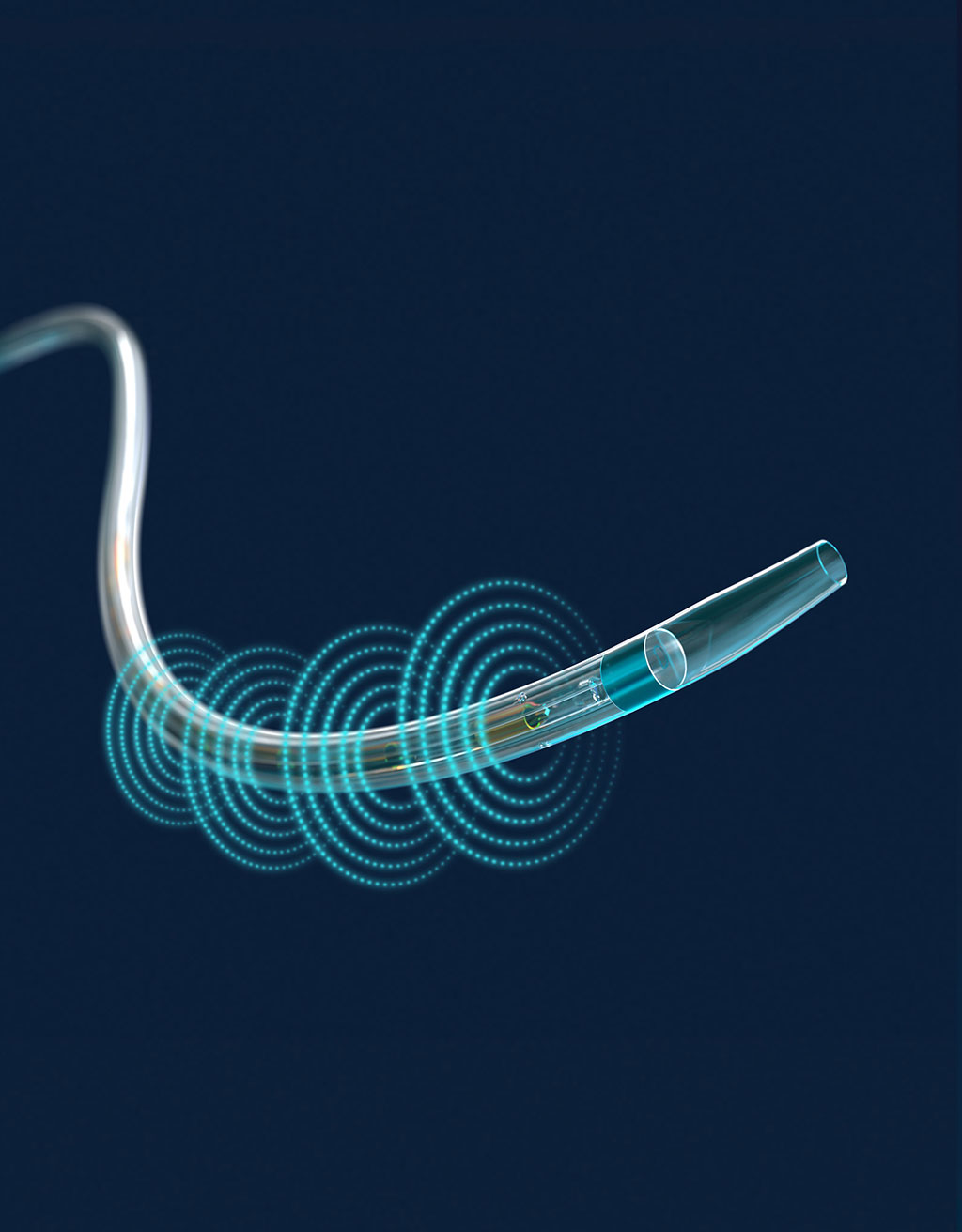Endovascular Ultrasonic System Treats Pulmonary Embolisms
|
By HospiMedica International staff writers Posted on 18 Oct 2021 |

Image: The EkoSonic IDDC and removable coaxial ultrasound transducer core (Photo courtesy of EKOS Corporation)
An ultrasound-facilitated catheter-directed low-dose fibrinolysis device accelerates the penetration of thrombolytic agents into pulmonary embolisms (PEs).
The Boston Scientific (Natick, MA, USA) EkoSonic (EKOS) Endovascular System is intended for the treatment of PE patients with a 50% or more clot burden in one or both of the main pulmonary or lobar arteries. The device consists of an intelligent drug delivery catheter (IDDC), an infusion catheter with a removable coaxial ultrasound transducer core, and a microsonic device (MSD). The acoustic energy conditions blood clots by thinning fibrin, increasing porosity, and creating a pressure gradient that transports the thrombolytic drug into the occluding thrombus.
In an international registry study published in 2020 in Circulation Cardiovascular Interventions that included 489 patients treated with the EKOS system, there were no intracerebral hemorrhagic (ICH) events and a major bleeding rate of 2.5%, significantly lower than with a systemic thrombolysis drug. The results also demonstrated a 23% post-procedure reduction in the main indicator of heart strain from PE, measured as right ventricular to left ventricular diameter ratio (RV/LV).
“As the largest prospective body of evidence in the interventional PE space to date, the registry provides an accurate modern representation of patients with PE treated with the EKOS system every day,” said Michael Jaff, DO, chief medical officer of peripheral interventions at Boston Scientific. “The strong safety and efficacy findings exhibited in this registry add to the existing clinical evidence supporting the EKOS system as a treatment option that physicians can trust.”
“PE remains a life-threatening and complex disease, but these results provide an opportunity to advance patient care by showcasing evidence that proves a lower drug dose and shorter infusion duration of a thrombolytic agent may result in enhanced safety and efficacy,” said Keith Sterling, MD, of Inova Alexandria Hospital (Alexandria, VA, USA). “The findings in this registry analysis are very reassuring to physicians making critical evidence-based decisions for their patients in what are oftentimes emergent treatment situations.”
PE is a blockage of an artery in the lungs, most commonly due to deep vein thrombosis (DVT) arising from peripheral veins. Symptoms include shortness of breath, chest pain, and coughing up blood. PE warning signs include low blood oxygen levels, rapid breathing, a rapid heart rate, and sometimes a mild fever. In many cases the affected extremity will be painful, swollen, red, and warm, and the superficial veins may be engorged.
Related Links:
Boston Scientific
The Boston Scientific (Natick, MA, USA) EkoSonic (EKOS) Endovascular System is intended for the treatment of PE patients with a 50% or more clot burden in one or both of the main pulmonary or lobar arteries. The device consists of an intelligent drug delivery catheter (IDDC), an infusion catheter with a removable coaxial ultrasound transducer core, and a microsonic device (MSD). The acoustic energy conditions blood clots by thinning fibrin, increasing porosity, and creating a pressure gradient that transports the thrombolytic drug into the occluding thrombus.
In an international registry study published in 2020 in Circulation Cardiovascular Interventions that included 489 patients treated with the EKOS system, there were no intracerebral hemorrhagic (ICH) events and a major bleeding rate of 2.5%, significantly lower than with a systemic thrombolysis drug. The results also demonstrated a 23% post-procedure reduction in the main indicator of heart strain from PE, measured as right ventricular to left ventricular diameter ratio (RV/LV).
“As the largest prospective body of evidence in the interventional PE space to date, the registry provides an accurate modern representation of patients with PE treated with the EKOS system every day,” said Michael Jaff, DO, chief medical officer of peripheral interventions at Boston Scientific. “The strong safety and efficacy findings exhibited in this registry add to the existing clinical evidence supporting the EKOS system as a treatment option that physicians can trust.”
“PE remains a life-threatening and complex disease, but these results provide an opportunity to advance patient care by showcasing evidence that proves a lower drug dose and shorter infusion duration of a thrombolytic agent may result in enhanced safety and efficacy,” said Keith Sterling, MD, of Inova Alexandria Hospital (Alexandria, VA, USA). “The findings in this registry analysis are very reassuring to physicians making critical evidence-based decisions for their patients in what are oftentimes emergent treatment situations.”
PE is a blockage of an artery in the lungs, most commonly due to deep vein thrombosis (DVT) arising from peripheral veins. Symptoms include shortness of breath, chest pain, and coughing up blood. PE warning signs include low blood oxygen levels, rapid breathing, a rapid heart rate, and sometimes a mild fever. In many cases the affected extremity will be painful, swollen, red, and warm, and the superficial veins may be engorged.
Related Links:
Boston Scientific
Latest Critical Care News
- CPR Guidelines Updated for Pediatric and Neonatal Emergency Care and Resuscitation
- Ingestible Capsule Monitors Intestinal Inflammation
- Wireless Implantable Sensor Enables Continuous Endoleak Monitoring
- Pulse Oximeter Index Offers Non-Invasive Guides for Fluid Therapy
- Wearable Patch for Early Skin Cancer Detection to Reduce Unnecessary Biopsies
- 'Universal' Kidney to Match Any Blood Type
- Light-Based Technology to Measure Brain Blood Flow Could Diagnose Stroke and TBI
- AI Heart Attack Risk Assessment Tool Outperforms Existing Methods
- Smartphone Imaging System Enables Early Oral Cancer Detection
- Swallowable Pill-Sized Bioprinter Treats GI Tract Injuries

- Personalized Brain “Pacemakers” Could Help Patients with Hard-To-Treat Epilepsy
- Microscopic DNA Flower Robots to Enable Precision Medicine Delivery
- Origami Robots to Deliver Medicine Less Invasively and More Effectively
- Improved Cough-Detection Technology Aids Health Monitoring
- AI Identifies Children in ER Likely to Develop Sepsis Within 48 Hours
- New Radiofrequency Therapy Slows Glioblastoma Growth
Channels
Surgical Techniques
view channel
Robotic Assistant Delivers Ultra-Precision Injections with Rapid Setup Times
Age-related macular degeneration (AMD) is a leading cause of blindness worldwide, affecting nearly 200 million people, a figure expected to rise to 280 million by 2040. Current treatment involves doctors... Read more
Minimally Invasive Endoscopic Surgery Improves Severe Stroke Outcomes
Intracerebral hemorrhage, a type of stroke caused by bleeding deep within the brain, remains one of the most challenging neurological emergencies to treat. Accounting for about 15% of all strokes, it carries... Read morePatient Care
view channel
Revolutionary Automatic IV-Line Flushing Device to Enhance Infusion Care
More than 80% of in-hospital patients receive intravenous (IV) therapy. Every dose of IV medicine delivered in a small volume (<250 mL) infusion bag should be followed by subsequent flushing to ensure... Read more
VR Training Tool Combats Contamination of Portable Medical Equipment
Healthcare-associated infections (HAIs) impact one in every 31 patients, cause nearly 100,000 deaths each year, and cost USD 28.4 billion in direct medical expenses. Notably, up to 75% of these infections... Read more
Portable Biosensor Platform to Reduce Hospital-Acquired Infections
Approximately 4 million patients in the European Union acquire healthcare-associated infections (HAIs) or nosocomial infections each year, with around 37,000 deaths directly resulting from these infections,... Read moreFirst-Of-Its-Kind Portable Germicidal Light Technology Disinfects High-Touch Clinical Surfaces in Seconds
Reducing healthcare-acquired infections (HAIs) remains a pressing issue within global healthcare systems. In the United States alone, 1.7 million patients contract HAIs annually, leading to approximately... Read moreHealth IT
view channel
Printable Molecule-Selective Nanoparticles Enable Mass Production of Wearable Biosensors
The future of medicine is likely to focus on the personalization of healthcare—understanding exactly what an individual requires and delivering the appropriate combination of nutrients, metabolites, and... Read moreBusiness
view channel
Philips and Masimo Partner to Advance Patient Monitoring Measurement Technologies
Royal Philips (Amsterdam, Netherlands) and Masimo (Irvine, California, USA) have renewed their multi-year strategic collaboration, combining Philips’ expertise in patient monitoring with Masimo’s noninvasive... Read more
B. Braun Acquires Digital Microsurgery Company True Digital Surgery
The high-end microsurgery market in neurosurgery, spine, and ENT is undergoing a significant transformation. Traditional analog microscopes are giving way to digital exoscopes, which provide improved visualization,... Read more
CMEF 2025 to Promote Holistic and High-Quality Development of Medical and Health Industry
The 92nd China International Medical Equipment Fair (CMEF 2025) Autumn Exhibition is scheduled to be held from September 26 to 29 at the China Import and Export Fair Complex (Canton Fair Complex) in Guangzhou.... Read more














